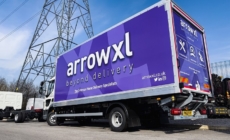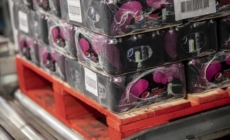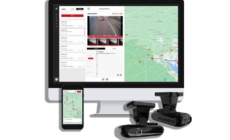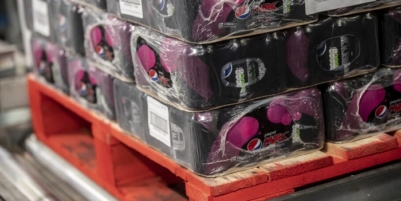-
ARROWXL SECURES FIFTH CONSECUTIVE GOLD ROSPA AWARD - April 19, 2024
-
Delivery management platform, Scurri topped over €12 billion in Gross Merchandise Value (GMV) in the total value of shipments processed in 2023 - April 17, 2024
-
Britvic reaffirms partnership with LPR - April 17, 2024
-
Kammac Supports Nimble’s Expansion into 500 Tesco Stores - April 5, 2024
-
Axiom Sustainability Software launches groundbreaking Social Value Calculator - April 4, 2024
-
Change to minimum wage and its impact on logistics - April 3, 2024
-
PARKSAFE GROUP TEAMS UP WITH QUECLINK WIRELESS SOLUTIONS IN FLEET TECHNOLOGY PARTNERSHIP - March 27, 2024
-
Facing shocking levels of violence at work – yet not paid enough to live on: 57% of UK retail staff say their wages barely cover basic expenses, despite many working more hours than ever - March 26, 2024
-
Bridgestone proving the worth of its Duravis Van tyre through academic study - March 25, 2024
-
Fleetmaxx Solutions announces Vanaways partnership - March 25, 2024
Ken Fleming, President, Logistyx Technologies
It is clear that Covid-19 has had a real and lasting effect on B2B e-commerce sales: research from McKinsey found that more than three-quarters of buyers prefer digital self-serve and remote human engagement to face-to-face interaction. With forecasts suggesting that the global B2B e-commerce market will reach up to $20.9 trillion by 2027, it is worth looking at the specific delivery needs and expectations of business e-commerce customers. What factors do you need to consider to fulfil orders most profitably for your B2B customers?
- Be on-time, every time
For businesses, on-time delivery can be business-critical. An entire manufacturing operation or assembly line could grind to a halt if critical components or raw materials fail to arrive on time. So B2B customers need dependable deliveries to reliably help them replenish parts and product to prepare for sales cycles. This means it is essential that your transportation management software guarantees real-time visibility and full transparency of the order status even as a package moves from carrier to carrier. If there are any unexpected delays, you want to get notified automatically, so you can take proactive steps to resolve issues before they become a major problem.
- Nurture carrier relationships
Developing relationships with carriers should be a top priority. As a B2B shipper, often, less is more: you may not need a huge carrier network. Due to the nature of B2B e-commerce, work can typically fall into a routine or cycle in which inventories need to be replenished at predictable intervals. Hence most B2B companies prefer to work with a smaller group of the most dependable carrier services, rather than including as many options as possible. Building relationships with these trusted carriers will help you better serve B2B customers by keeping shipping costs and fees low and ensuring reliable on-time deliveries.
- Don’t get caught up in bells and whistles
In general, dependable, consistent, on-time execution and order status visibility will keep B2B customers happy. Many will never request or need expedited shipping, which may be prohibitively costly anyway, due to the larger shipments involved in business orders. By planning ahead, business customers are largely able to avoid paying for options they don’t need such as same-day or next-day delivery. And unlike your B2C customers they are unlikely to require locker pick-ups, in-store pickups, or other communal delivery options. But they do need suppliers to be very good at the essential elements: shipping large deliveries in a timely and cost-effective manner.
- Don’t get complacent
Having said that B2B shipping is mainly about getting the essentials – such as on time delivery and accuracy of order – right, you still need to keep reviewing your offer. Changes may be afoot. Statistics show that 73% of online business buyers are millennials (born between 1982 and 2000). These are people who have grown up with Amazon. They are particularly demanding when it comes to responsiveness and customer service. For example, even in B2B settings, some of them demand quick delivery, with 56% expecting same day delivery as standard. Of course, the major change in successful logistics e-commerce, in both B2C and B2B, is the shift from push to pull. Where previously the supplier dictated delivery conditions, it is now the customer who is increasingly in control.
- Ask your customers for feedback, regularly
While a consumer may order from a business only once, your B2B customers are generally looking for a supplier they can order from regularly – and usually at higher order values than B2C customers. So, seeking regular feedback from business clients is vital to ensuring their satisfaction, making it easier to identify problems early while they can still be addressed proactively. These relationships should be nurtured and developed over time, because losing one B2B customer can negatively affect the bottom line well into the future. Investing time understanding and addressing any problems that may arise can pay big dividends in client retention.
- Invest in the right technology
Clearly, the stakes are high for mastering the B2B shipping experience, so it is important to know what to look for in a transportation management technology if you’re shipping parcels to business customers. It goes without saying that it should improve the status of carrier procurement, fulfilment operations, customer service and finance. But not all solutions are created equal; to get the maximum benefit make sure that it offers helpful features, including real-time delivery status updates and visibility to proactively respond to potential problems and deliver superior customer service. You may need integration and real-time ‘best fit’ selection of carrier services, including global carriers when necessary and full carrier compliance so that you can meet all the needs of your customers’ preferred carriers.
It is already clear that successful B2B e-commerce businesses are already ditching efficient – but rigid – supply chains and introducing flexibility to meet the needs of a new generation of business buyers. In a world where everything is changing, following these six steps will give B2B e-commerce suppliers the best possible chance of success.

































